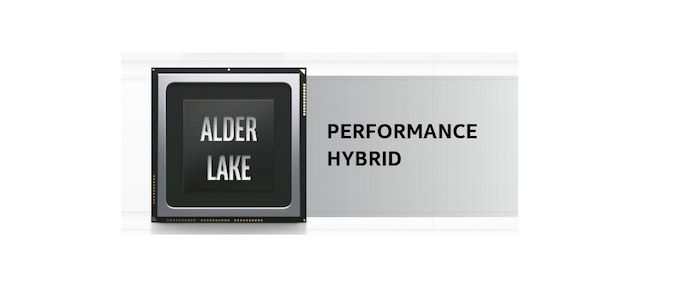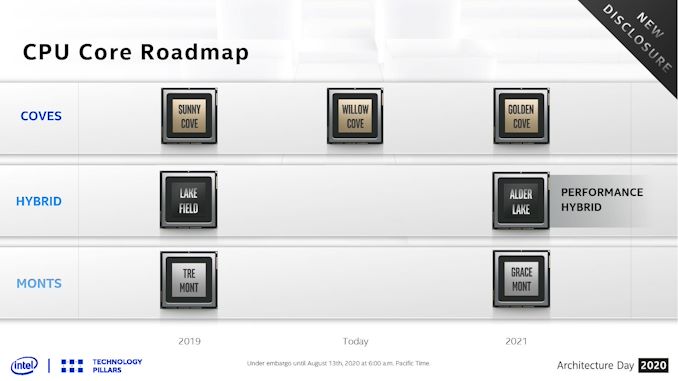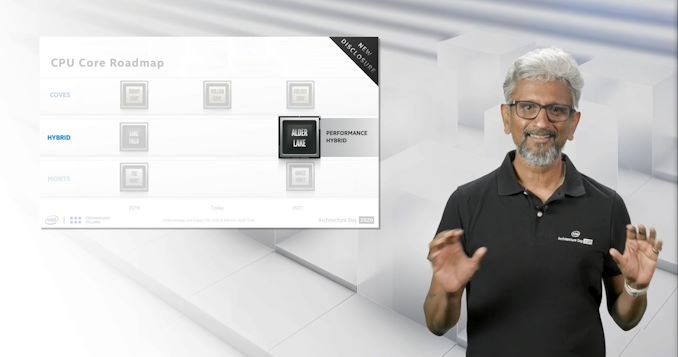Intel Alder Lake: Confirmed x86 Hybrid with Golden Cove and Gracemont for 2021
by Dr. Ian Cutress on August 14, 2020 1:05 PM EST- Posted in
- CPUs
- Intel
- Alder Lake
- Hybrid
- Intel Arch Day 2020

Following leaks is often a game of cat and mouse – what is actually legitimate and what might not be. Traditionally AnandTech shies away from leaks for that very reason, and we prefer to have multiple sources that are saying the same thing, rather than addressing every potential rumor on the blogosphere. Nonetheless, hints towards a new product from Intel, Alder Lake, have been cropping up over the past few months, including getting a small mention in Intel’s Q2 2020 earnings. The leaks have suggested that it would offer a mixed Hybrid x86 environment similar to Intel’s current Lakefield product that uses high-performance cores paired with high-efficiency cores. As part of Intel’s Architecture Day 2020, the company officially announced Alder Lake as a hybrid x86 product on its roadmaps.
In the roadmap and as part of the discussions, Intel’s Raja Koduri confirms that Alder Lake will be a combination of the Golden Cove high performance computing core and the Gracemont high efficiency core, and the goal of this chip is to offer a ‘Performance Hybrid’ option into the portfolio. Raja explained to the audience that the company has learned a lot due to building Lakefield, its current hybrid x86 chip for thin and light notebooks, and while Lakefield was focused on battery life, Alder Lake will focus instead on performance.
Alder Lake will involve Intel’s next generation hardware scheduler, which we are told will be able to leverage all cores for performance and make it seamless to any software package. Intel claims that Alder Lake will be Intel’s best (ever? 2021?) performance-per-watt processor.
If leaks are to be believed, then Alder Lake looks set to offer an 8+8 design, although that has not been confirmed. Intel did not go into detail if Alder Lake will involve any next generation packaging, such as Foveros (which Lakefield does) – but in the Q2 2020 financial disclosures, it was said to be positioned for mobile and desktops. We expect Intel to discuss Golden Cove and Gracemont at some point next year, and then Alder Lake as an extension to those – we have already seen Intel documents regarding new instructions for each of these cores. My prediction is to come back this time next year, where we should have more to talk about.
Related Reading
- Intel Updates ISA Manual: New Instructions for Alder Lake, also BF16 for Sapphire Rapids
- Intel Roadmap Update: Alder Lake In H2’21, Ice Lake-SP Late This Year
- Intel’s 11th Gen Core Tiger Lake SoC Detailed: SuperFin, Willow Cove and Xe-LP
- The Intel Xe-LP GPU Architecture Deep Dive: Building Up The Next Generation
- The Intel Lakefield Deep Dive: Everything To Know About the First x86 Hybrid CPU












89 Comments
View All Comments
Meteor2 - Tuesday, August 18, 2020 - link
A53 was a very long-lived design; I don't expect A55 to be very different. The RoI to develop further increases in efficiency in the power and thermal budgets the "efficiency" cores live in probably isn't judged to be worth frequent updatesSpunjji - Monday, August 17, 2020 - link
"8+32 can credibly compete with AMD's 16-core"I do wonder about this one. In theory it could do very well - but memory contention already starts to bite pretty hard on the 3950X, so wouldn't that problem be multiplied by having 40 cores (regardless of size) on the same chip?
nandnandnand - Monday, August 17, 2020 - link
Well, the 40-core ain't happening, it's just hypothetical, but maybe DDR5 could improve the situation? Alder Lake may even be using DDR5, if not, probably everything launched afterwards will.AMD's Mark Papermaster has said the company will increase core counts on mainstream Ryzen CPUs, so we will probably see the 3950X-tier flagship go to 24 or 32 cores by Zen 4/5.
drothgery - Friday, August 14, 2020 - link
It's not clear to me what Intel's HEDT plans are post-Cascade Lake (presumably they'll have something based on Ice Lake SP or its successor eventually).If it Intel puts more than 8 'big' cores on a non-HEDT chip, it's for marketing, not because there's any real use case for it (which is why the 10-core non-HEDT i9s exist). Which is why AMD did it, too.
yeeeeman - Saturday, August 15, 2020 - link
While I like many cores CPUs like 3950x, I think having a 8 big cpu cores that are much faster than AMD cores and 8 smaller cores work together would be better in the end for both pure performance and efficiency. While having the same type of cores is nice, in the end there are benefits to having different cores for different purposes like mobile chips have already for quite a long time.Quantumz0d - Saturday, August 15, 2020 - link
And what exactly is that ? Mobile trash always does it because to save that pathetic battery technology. This doesn't belong in desktops where the Clockspeed matters a lot and that adjusts your efficiency with Turbo Boost you already have it.. Why do you need a small trash core doing the work with reduced performance ? You are not going to save anything except making the work finished in longer period.This bullshit Intel approach is because to keep their SMT performance, they cannot scale with Ring bus it's game over for Intel after this SKL, which was max at 10C, that's why RKL is not 10C at-least from rumors, it's not an SKL uArch part so it's having this uneven SMT distribution too, 8C/12T & Mesh is trash as it gobbles up power like anything too inefficient is the reason.
This is a joke from Intel which is getting nasty with each of their moves after 10nm debacle.
nandnandnand - Sunday, August 16, 2020 - link
If 4 Atom cores is about the same die area as 1 big core, but with better multi-threaded performance, that is a benefit.mattbg - Monday, August 17, 2020 - link
Statements like "best performance-per-watt" and mentions of notebooks in the same breath as desktops make me wonder if this is really what half of us are expecting. This might be a high performance CPU for constrained form factors rather than some kind of balls-out desktop successor to the 11700K.And why wouldn't it be? That's what normal, non-enthusiast people are willing to pay more for, and there are a lot more of those people.
If it was a pure performance part, why would it be using low power cores?
JayNor - Friday, August 14, 2020 - link
"but in the Q2 2020 financial disclosures, it was said to be positioned for mobile and desktops."Yes, I believe the Alder Lake use for mobile was mentioned somewhere in the architecture day presentations also. It makes a lot of sense to me, assuming the small core performance is a cut above hyper-thread performance.
I'd also be surprised if there isn't a Lakefield successor.
KimGitz - Friday, August 14, 2020 - link
Alder Lake is the Lakefield successor. While the desktop variant Alder Lake S goes upto 8 Big Cores, the mobile variant Alder Lake P maxs out at 6 Big Cores. According to leaks there are 3 skus with 2 Big Cores and a combination of 8, 4 or 0 little cores (2+8, 2+4, 2+0) and one with 4 Big Cores paired with 8 little cores. Lakefield only had one big core which was not competitive so the lowest next gen hybrid CPUs from Intel will have 2 Big Cores. The desktop variants has one sku with 4 Big Cores paired and another with 2 Big Cores in the lower end, both with no little cores. The desktop Alder Lake P comes with GT1 rated iGPU while the mobile variants have GT2, this are probably the upgrade to Gen 12 Xe-LP. All these are according to leaks and with Intel one can't be confident predicting what will actually happen.